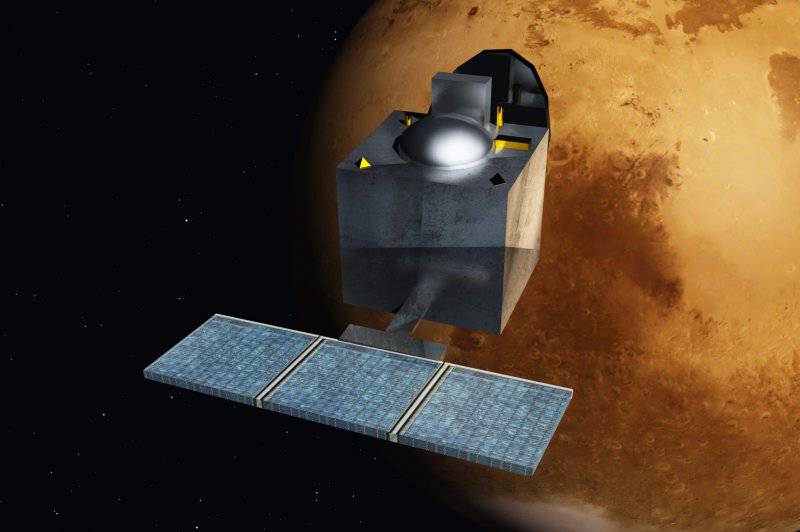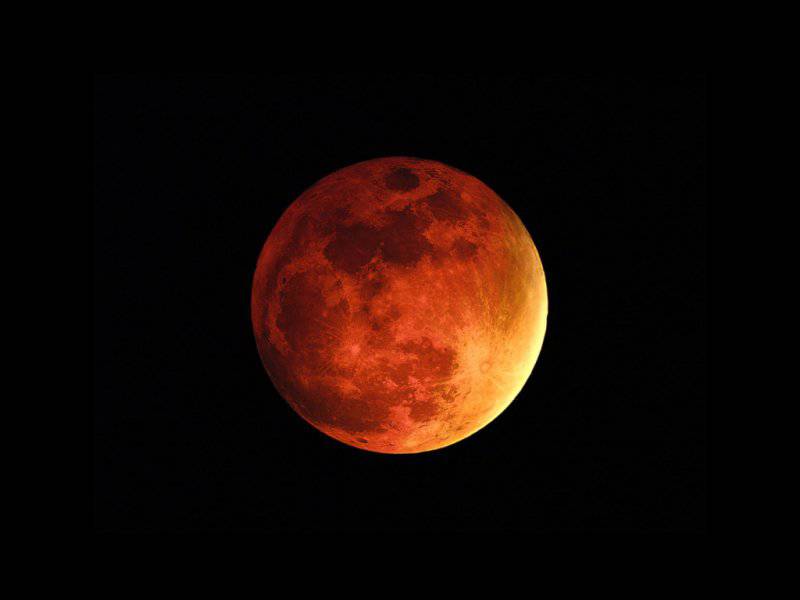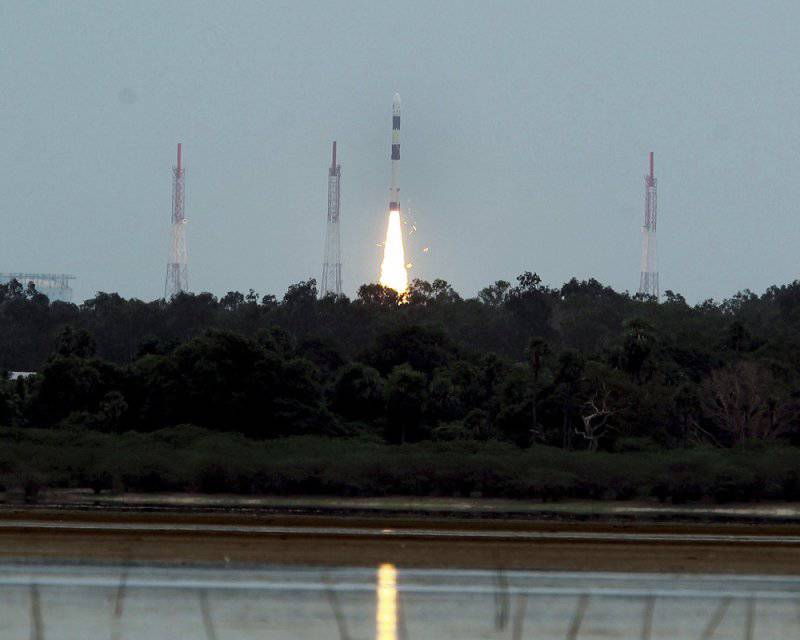India conquers Mars
Indian probe can be safely attributed to a kind of low-cost airlines. The golden-colored ship cost India only a total of 74 million dollars (construction and launch). While his American counterpart, called Maven, was worth 10 times more. But that's not all. The Indian ship was designed in no time. To do this, Indian engineers took just 15 months. On Wednesday morning, September 24 2014, an Indian probe the size of a small car and weighing a little over 1 tons managed to gain a foothold in Mars orbit. The launch of low-budget satellites to the red planet was carried out earlier, but India was able to complete the task with a rare success for these missions, says the head of the Space Policy Institute Ivan Moiseyev.
Already on September 25, the first pictures of Mars, which were made by the Indian apparatus Mangalyaan, were published on the network, reports BBC News. Photos of Mars were taken from a distance of thousands of kilometers from 7,3. They can see the craters in the form of dark depressions on the orange surface of the planet. The images taken by the device were published on the official pages of the Indian Space Research Organization (ISRO), for example, on Facebook.
According to the world media, other countries have made a total of about 40 attempts to launch probes to Mars, of which only 20 have become successful. The Indian probe Mangalyaan on Monday, September 22, checked the engine, and on Wednesday around 6: Moscow time 15 successfully went into orbit of the red planet, becoming the first Indian-made spacecraft that was launched to another planet. The tasks of this spacecraft include photographing the surface of Mars, studying its atmosphere, and working out technologies for carrying out new flights to the red planet. Also, the satellite must establish whether there is methane on Mars and whether there was water on the planet. It is assumed that the spacecraft carrying the 15 kg of scientific equipment will work in the orbit of the red planet for about 6 months, the maximum program will last 10 months.
Satellite "Mangalyan" was launched yet 5 November 2013 of the year. The launch was carried out from the territory of the Satish Dhavan Space Center, which is located on the island of Sriharikota, located in the Bay of Bengal. The mission has already become the cheapest of all that ever went to the red planet. The numbers in 74 million dollars or even 67 million are called, as Time magazine reports. Almost simultaneously, Mars satellite 10 came out and the American satellite MAVEN, about which 22 September was reported by NASA.
The idea of sending cheap spacecraft to Mars is not new. In our country, the use of devices with a small set of scientific instruments moved to 1980-s. At the same time, Russia was very unlucky with two extremely expensive projects. The Mars-96 space stations in 1996 and Phobos-Grunt in 2011 did not fulfill their functions, their launches ended in failure. In the future plans of Russia, according to Ivan Moiseyev, the study of the Moon with the help of small stations.
The Indian probe has already begun to study the atmosphere of the red planet, but its main function is to test the technologies that may be needed to accomplish a manned flight. The study of Mars today is interesting, without exception, for all space powers, as it will help to answer the question of how our universe works, Oleg Weisberg, an active member of the International Academy of Astronautics, said.
Mars as a planet is very interesting to earth scientists. He has undergone a great evolution. Mars has a sufficiently developed atmosphere, water, there is a chance that there was a life on the planet that could survive to this day in some very simple form. From the point of view of evolution, the red planet is close enough to the Earth, and how our neighbors developed was very important for understanding how our own planet developed and will develop. In addition, there is an idea to colonize Mars, according to Weisberg, this can happen in 200 or 300 years.
So far, apart from India, only NASA, the European Space Agency and Roscosmos have taken their own devices into the orbit of Mars. Now this peak is also conquered by Indian engineers. Their satellite will rotate around the planet, approaching it at the closest distance in 420 km. Becoming the first country to successfully send a mission to Mars on the first attempt, India is becoming a powerful space power, which in the future can press Russia on the market for commercial launches.
To fly to Mars, the Indian probe traveled 10 millions of kilometers in 780 months. The Mission Control Center, located in the city of Bangalore, received confirmation of the apparatus’s entry into the Martian orbit on 7: 41 in the morning (local time) 24 in September. All local TV programs reported about this event, the front pages of Indian newspapers were devoted to it. Even children wrote letters to their parents about the flight of the spacecraft to Mars, while in many churches they prayed for the success of the expedition.
The Indian probe was very cheap. Sending him to Mars cost the treasury 4,5 billion rupees (about 74 million dollars), although these costs were criticized by some people against the backdrop of undefeated poverty and hunger in India. At the same time, the Indian government believes that the launch is very important for the development of modern space technologies, as well as the creation of its own highly developed production and the necessary reserve for the future. It is worth taking into account the fact that the launch was fraught with a high degree of risk - of all the launches carried out to Mars, more than half ended in failure.
Today, Indian Prime Minister Narendra Modi plans to make India a full-fledged player in the space technology market, the total amount of which is estimated by experts at 300 billions of dollars. At the same time, India will have to compete with China, which has gained momentum, which already has its own heavy launch vehicles. At the same time, the unofficial interplanetary Martian tournament allowed Delhi to test its Polar Sattelite Launch Vehicle (PSLV) rocket, which in the future could press Russian RN on the market for commercial launches of various spacecraft. So far, this rocket has a very good history launches: 26 successive launches were made after the first, which ended in failure. During these launches, 40 of foreign satellites were launched into Earth orbit. The Indian rocket is able to put 620 kilograms of payloads into 1600-kilometer orbit and up to 1050 kilograms of transition geosynchronous orbit. In the standard configuration, the PSLV rocket has a mass of 295 tons and has a length of 44 meter. The solid-fuel first stage of the Indian rocket is one of the most powerful in the world today; this accelerator carries 139 tons of fuel.
The Indian Martian spacecraft with a total weight of 1350 kg, going into an elliptical orbit around Mars, will have to study the composition of the surface of the planet, the atmosphere and the cosmic environment of the red planet. One of the main tasks of the mission is the search and study of methane, which is present in the atmosphere of the fourth planet, as well as the search for its possible sources. A photometer specially installed on the satellite will try to estimate how quickly water evaporates from Mars.
The Indian mission to study Mars was announced in 2012 year. The failure of China, which unsuccessfully launched its interplanetary spacecraft in the 2011 year, made this project poignant.
Information sources:
http://www.gazeta.ru/science/2014/09/24_a_6233597.shtml
http://www.kommersant.ru/doc/2574198
http://www.utro.ru/articles/2014/09/25/1214205.shtml



Information